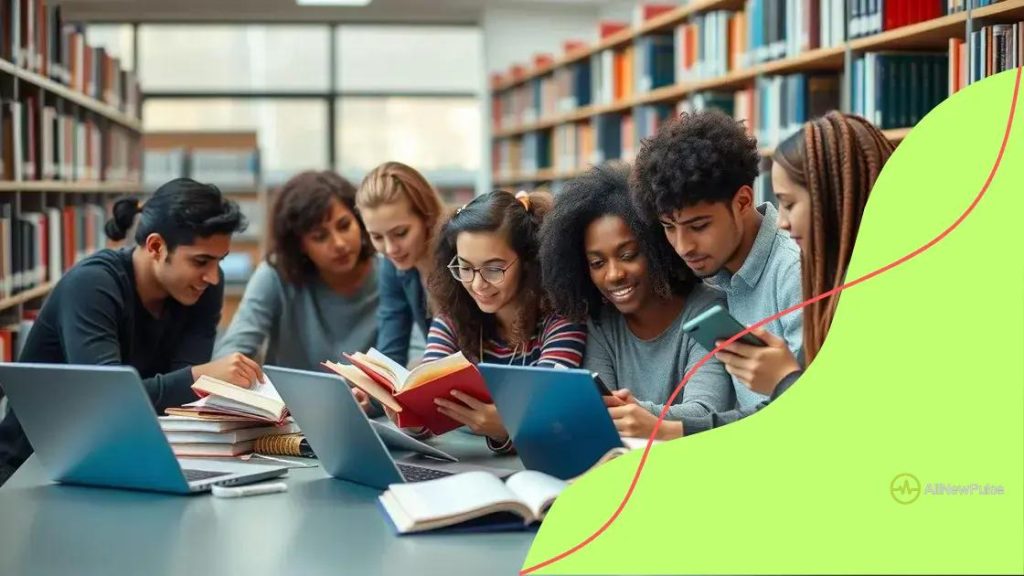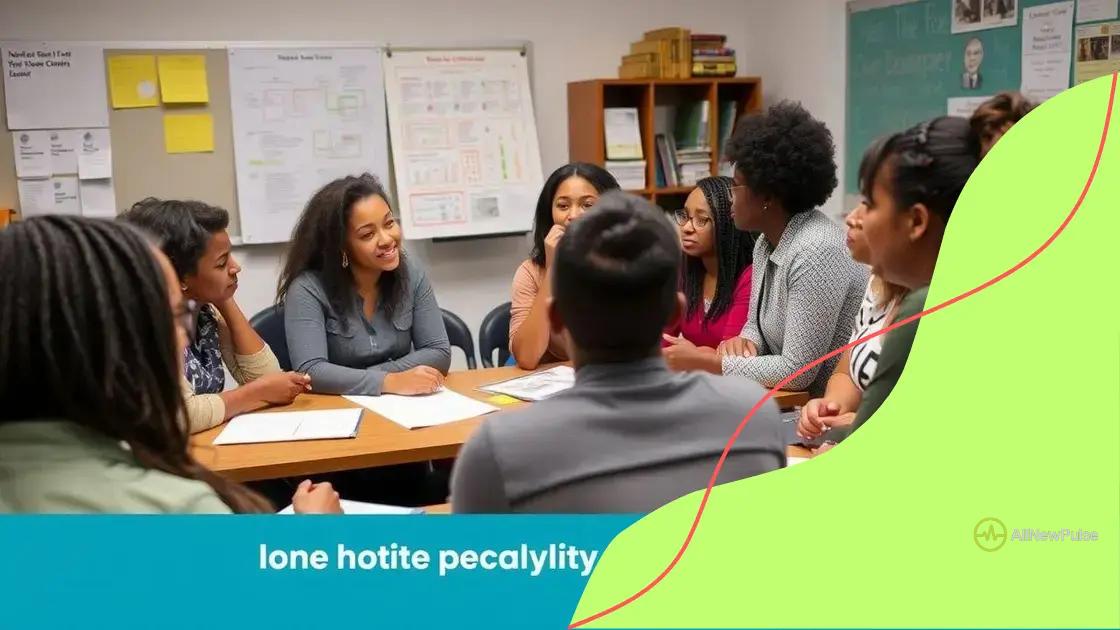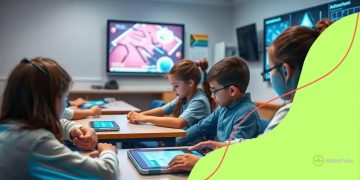Addressing issues of equity and access in higher education

Addressing issues of equity and access in higher education involves identifying barriers like financial constraints and lack of support, implementing tailored initiatives, and leveraging technology to create inclusive educational environments for all students.
Addressing issues of equity and access in higher education is vital for creating inclusive learning environments. Have you ever considered how these issues impact students’ lives and opportunities? Let’s explore how we can tackle these challenges.
Understanding equity in education
Understanding equity in education is essential for fostering learning environments that support all students. It focuses on ensuring that every student has access to the same opportunities and resources necessary for success.
Equity goes beyond equality, which means providing the same resources to everyone. Instead, equity recognizes that some students may need additional support. This can include resources such as tutoring, mentoring, and financial aid.
The Key Concepts of Educational Equity
To grasp the full scope of educational equity, it’s vital to understand several key concepts:
- Accessibility: Ensuring that all students can physically access learning environments.
- Inclusivity: Creating an atmosphere where all students feel valued and can participate fully.
- Support: Offering tailored resources that address individual student needs.
- Outcomes: Focusing on results that demonstrate all students’ achievements.
By acknowledging the diverse backgrounds and experiences of students, educational institutions can better address the challenges they face. For instance, recognizing the impact of socioeconomic status allows schools to implement programs that offer extra academic support to those in need.
Furthermore, it’s essential to incorporate cultural competence into teaching practices. Educators who understand and respect the diverse cultures of their students can create more engaging and relevant learning experiences.
Incorporating these principles of equity can lead to improved academic performance and increased motivation among students. Schools can establish partnerships with community organizations to enhance support. This collaboration can provide students with mentorship, internships, and additional learning opportunities aligned with their interests and needs.
Challenges to Achieving Equity
Despite the importance of equity, several challenges exist. Some common barriers include:
- Funding disparities: Varying levels of funding can lead to unequal resources across schools.
- Bias: Unconscious biases can influence educators’ expectations and treatment of students.
- Policy barriers: Legislative decisions may fail to account for the unique needs of diverse student populations.
Addressing these challenges is not easy, but raising awareness is a critical first step. Schools can lead discussions about equity and involve the community in finding solutions. Activating parents and community members can create a supportive network that advocates for resources and policies that promote fairness in education.
Barriers to access in higher education
Barriers to access in higher education are significant challenges that many students face. Understanding these barriers is crucial for improving opportunities for all students, especially those from underrepresented backgrounds.
Some common barriers include financial constraints, inadequate academic preparation, and a lack of support systems. These issues often prevent capable students from pursuing their dreams of higher education.
Financial Barriers
The cost of attending college can be overwhelming. Many students struggle to afford tuition, housing, and books. The fear of accumulating debt can stop potential students from even applying.
- Tuition costs: Rising tuition rates make higher education less accessible.
- Financial aid complexities: The process of applying for financial aid can be confusing and discouraging.
- Living expenses: Many students need to work while studying, which can impact their academic performance.
Additionally, students from low-income families may not have the resources to apply for financial aid. They may also lack access to information about scholarships that could ease their financial burden.
Academic Preparation
Another significant barrier is the lack of adequate academic preparation. Students who come from underfunded schools often do not receive the same quality education as their peers.
- Limited access to advanced courses: Some schools do not offer AP or honors courses, which help students prepare for college rigor.
- Standardized testing inequities: Differences in test preparation resources can impact students’ performance on college entrance exams.
- Supportive learning environments: A positive school culture can enhance academic success, but not all students experience this.
When students do not have the same opportunities in high school, it can hinder their chances of being accepted into college. This academic gap is a critical issue that needs to be addressed.
Social and emotional support also plays a vital role in a student’s journey to higher education. Many students lack mentors who can guide them through the application process.
The Role of Awareness
Raising awareness of these barriers is essential. Educational institutions and community organizations can work together to create programs that provide support and resources to underrepresented students. These initiatives can help level the playing field, ensuring that all students have a fair chance at higher education.
Effective strategies for promoting equity

Effective strategies for promoting equity in higher education are essential for creating an inclusive environment where every student can thrive. It is crucial to implement actions that address the diverse needs of all learners.
One effective strategy is to implement tailored support services for students. This could include tutoring, mentorship programs, and counseling services. These resources help to bridge the gap for students who may struggle with academic or personal challenges.
Building Inclusive Policies
Institutions can commit to building inclusive policies that target the root causes of inequity. By reviewing admission processes, schools can ensure that they do not unintentionally favor one group over another.
- Holistic admissions: Consider a student’s overall experiences rather than just standardized test scores.
- Scholarship opportunities: Offer targeted scholarships for underrepresented groups to encourage diversity.
- Support for first-generation students: Implement programs specifically aimed at helping first-time college students navigate the system.
By creating policies that account for the unique challenges faced by various student populations, educational institutions can better support everyone’s journey toward academic success.
Enhancing Community Engagement
Another effective strategy is to strengthen community engagement. Involving local communities can create a network of support for students. Collaborations between colleges and local organizations can bring additional resources to students.
- Community partnerships: Work with organizations that offer mentorship and internship opportunities.
- Workshops and seminars: Host events that educate students and families about college access and preparation.
- Open communication: Establish channels for feedback from students and community members to improve programs.
Creating a culture of engagement around equity encourages students to feel more connected and supported in their educational journey. This can have a positive impact on their overall academic experiences and outcomes.
Moreover, investing in professional development for faculty and staff is critical. Training can help educators better understand the needs of diverse learners. It equips them with strategies to foster inclusive classrooms, promoting a sense of belonging for all students.
Monitoring and Assessment
An ongoing assessment of policies and practices is vital for promoting equity. Schools should regularly evaluate their effectiveness in addressing inequity. This includes gathering data on student outcomes to identify areas for improvement.
- Data analysis: Examine enrollment and graduation rates to pinpoint disparities.
- Feedback mechanisms: Implement surveys and focus groups to learn about student experiences.
- Continuous improvement: Use findings to adapt programs and initiatives based on student needs.
By continuously assessing their strategies, educational institutions can ensure they are effectively promoting equity and making necessary adjustments to meet the evolving needs of their student populations.
The role of technology in enhancing access
The role of technology in enhancing access to higher education is increasingly important. Technology can help bridge gaps for students who face barriers to accessing educational opportunities.
One way technology enhances access is through online learning platforms. These platforms allow students from various backgrounds to participate in courses without the need to travel to a physical campus. This flexibility is especially beneficial for those with jobs or family commitments. Many schools now offer online degrees, providing more options for students.
Adaptive Learning Technologies
Adaptive learning technologies also play a crucial role in personalized education. These technologies adjust to each student’s learning pace and style, allowing for a more tailored learning experience. The advantages include:
- Individualized instruction: Students can receive lessons that suit their specific needs.
- Immediate feedback: Learners can quickly see how they’re doing and adjust accordingly.
- Accessible resources: Materials can be made available in various formats to support different learning styles.
Using adaptive technologies, educators can help students overcome learning obstacles and ensure they are better prepared for coursework.
Online Resources and Support
Moreover, technology offers a wealth of online resources that can aid students in their educational journey. Online libraries, academic databases, and tutoring services provide additional support for learners. These resources can be vital for students who do not have access to comprehensive libraries or tutoring services nearby.
- Virtual libraries: Students can access thousands of books and articles at any time.
- Study aids: Online tools like flashcards and quizzes can help reinforce learning.
- Accessible tutoring: Online tutoring makes academic support available to anyone with an internet connection.
While technology offers many advantages, it’s essential to ensure that all students have access to the necessary tools. This means providing devices and reliable internet connections to those who may not have them. Schools and organizations should work together to make technology accessible for everyone.
Case studies of successful initiatives
Case studies of successful initiatives in addressing equity and access in higher education offer valuable insights. These examples demonstrate how focused efforts can lead to meaningful change in the lives of students.
One notable example is the College Bound Program in Seattle. This initiative helps low-income students by providing them with resources, mentorship, and college-readiness workshops. As a result, program participants have seen significant increases in both college enrollment and persistence rates.
The Posse Foundation
Another successful initiative is the Posse Foundation, which identifies and trains diverse groups of students to succeed in college. The program focuses on building supportive networks among students. This helps participants from similar backgrounds adjust to the college environment. Many Posse alumni report higher graduation rates compared to their peers.
- Community support: Posse students receive continuous mentorship and guidance from alumni.
- Cohort model: Attending college as part of a team fosters strong bonds and encourages academic success.
- Partnerships: Collaborating with colleges creates tailored programs to meet student needs.
These strategies not only improve access but also enhance the overall college experience for underrepresented students.
City University of New York (CUNY) Initiatives
The City University of New York (CUNY) has implemented a range of initiatives aimed at increasing equity. One such initiative is the CUNY Accelerated Study in Associate Programs (ASAP). This program provides enrolled students with financial support, academic advising, and career planning. ASAP students achieve higher graduation rates compared to their counterparts.
- Financial assistance: Covers tuition and fees for eligible students, reducing financial barriers.
- Holistic support: Offers personalized academic counseling to keep students on track.
- Job placement: Provides avenues for internships and employment opportunities, enhancing employability.
CUNY’s efforts highlight the importance of comprehensive support systems in empowering students to reach their educational goals.
These case studies illustrate that concerted efforts can lead to improved equity and access in higher education. By learning from successful initiatives, other institutions can implement similar strategies to support diverse student populations effectively.
In conclusion, addressing issues of equity and access in higher education is crucial for creating a more just society. By understanding the barriers that students face, implementing effective strategies, and learning from successful case studies, we can foster an inclusive educational environment. The use of technology and personalized support systems can greatly enhance access for all students. Together, we can promote equal opportunities and empower every learner to achieve their academic goals.
FAQ – Questions about Addressing Issues of Equity and Access in Higher Education
What are the main barriers to access in higher education?
The main barriers include financial constraints, inadequate academic preparation, and lack of support systems that prevent students from pursuing their education.
How can technology enhance access to education?
Technology enhances access by providing online learning platforms, adaptive learning technologies, and a wealth of online resources that support students from various backgrounds.
What are some successful initiatives promoting equity in education?
Successful initiatives include the Posse Foundation and CUNY ASAP, which provide mentoring, financial support, and tailored programs to help underrepresented students succeed.
Why is continuous assessment important in promoting equity?
Continuous assessment allows institutions to evaluate their strategies’ effectiveness, identify areas for improvement, and adapt resources to better meet students’ needs.





